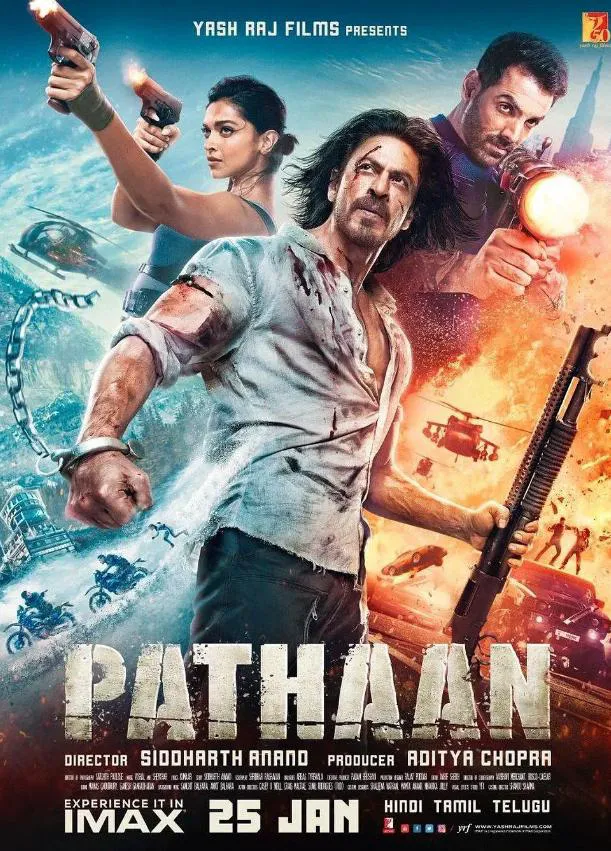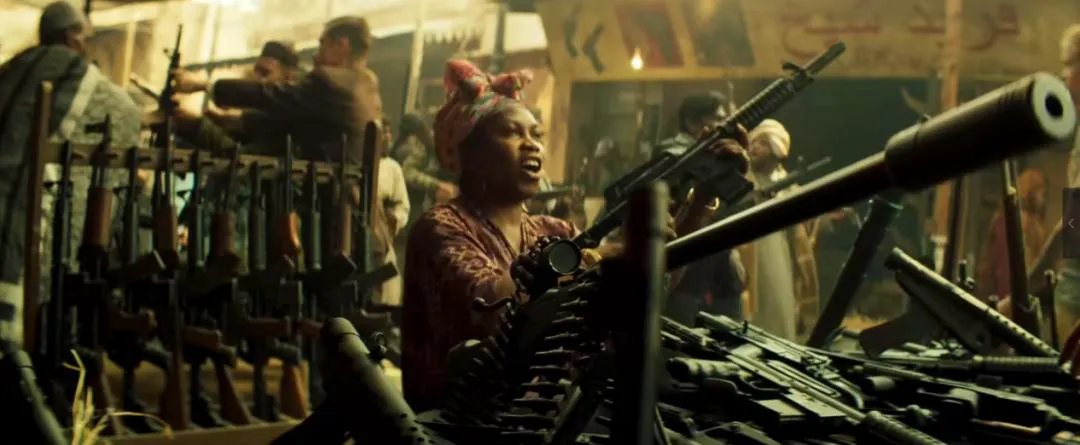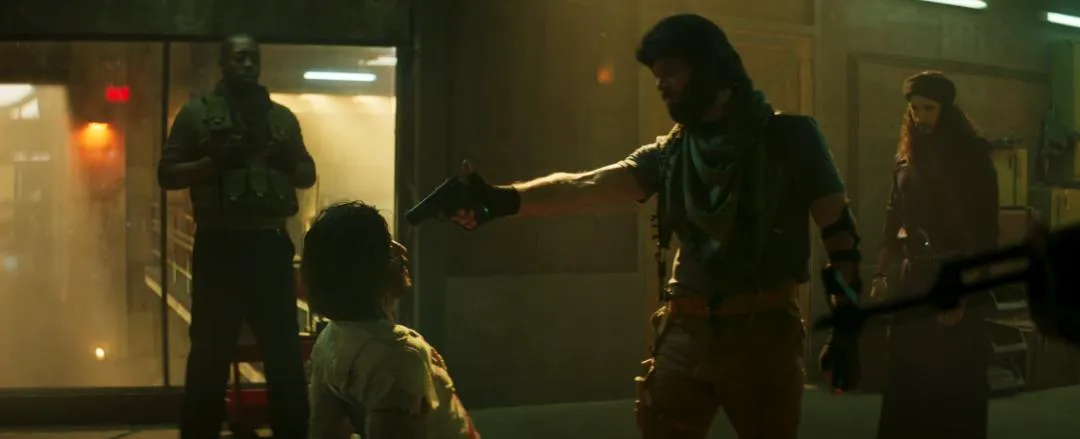In the realm of commercial art, the term “pastiche” or “stitch-up” is almost always a derogatory term. It implies a lack of originality, a reliance on existing ideas, and a general lack of creative vision.
Historically, audiences with a strong sense of justice have been quick to condemn works that heavily borrow from others, often criticizing them relentlessly.
However, a recent film has defied this trend, achieving international success through its audacious and unapologetic use of pastiche.
This film, which completely subverts expectations, is the Bollywood blockbuster known as the “Indian Wolf Warrior”:
“Pathaan.”

Given its reputation as the “Indian Wolf Warrior,” one might expect a film packed with intense action and nationalistic fervor. However, upon watching “Pathaan,” it becomes clear that it transcends such simple labels.
A Whirlwind Tour of Action Cinema
In my opinion, “Pathaan” is a melting pot of influences, drawing from Hollywood, South Korean action flicks, Bangkok thrillers, Chinese martial arts epics, Bollywood extravagance, Russian grit, and European postmodernism.
Watching it is like taking a crash course in the history of action cinema, witnessing its evolution over the past century.
As a pure action spectacle, logic takes a backseat.
Like South Korean narratives that often feature conflicts with North Korea, and American films that frequently pit the U.S. against Russia, “Pathaan” positions Pakistan as its primary antagonist.
However, the Pakistani operative in this film is far from typical.
The Villain: A Fallen Hero
This agent, named Jim, was once a top-tier Indian special forces soldier.
During a mission, Jim was captured, and the kidnappers demanded a hefty ransom from the Indian government.
The Indian government refused to pay, leading to the tragic death of Jim’s wife. This betrayal drove Jim to defect to Pakistan, where he now serves a radical Pakistani general.
Thus, the story becomes not only about fighting evil but also about confronting treachery.
The Protagonist: India’s Finest
Our hero, Pathaan, the second-generation “Indian Wolf Warrior,” is also a force to be reckoned with.
Pathaan, another elite Indian special forces operative, was inspired after being injured in action to form a special operations unit with other retired veterans, working for the Indian government.
Two years prior, Jim ambushed two Indian scientists in the UAE, reminiscent of the Winter Soldier’s attack on Captain America.
Pathaan intervened, leading to a brutal hand-to-hand fight with Jim, echoing the iconic Captain America vs. Winter Soldier showdown.
Pathaan successfully repelled Jim, but at the cost of his entire team.
Time passes, and Jim resurfaces.
This time, he appears in an arms market reminiscent of “Black Hawk Down,” seeking to purchase missiles.

Pathaan, his old adversary, is hot on his heels.
He ends up tied to a chair by the local warlord, much like Black Widow.
Pathaan escapes in a similar fashion, engaging in a more intense brawl reminiscent of “First Blood.”

The film’s fight choreography, while not particularly fluid, delivers a satisfyingly visceral experience.
The first half of the film is filled with references to famous Marvel scenes, suggesting that director Anand is a dedicated MCU fan.
Twists and Turns
As the flashbacks conclude, the story enters its second act.
Jim intentionally reveals his location, luring Pathaan into a trap.
However, just as Jim is about to eliminate Pathaan, a beautiful agent named Rubai, who works for Jim, suddenly betrays him and saves Pathaan.
She reveals that Jim plans to steal a virus from Russia and unleash it in India.
Armed with this new information, Pathaan and Rubai head to Russia, where they use their charm to obtain the key to a secret Russian base.
Just as they secure the virus, Rubai double-crosses Pathaan and disappears with the virus.
Pathaan is arrested by Russian security forces and subjected to interrogation.
This sequence, with its repeated betrayals and negative portrayal of Russia, is reminiscent of a “James Bond” film.
After Pathaan reveals his identity, his superiors deny any affiliation with him.
However, as he is being transported to prison, an Indian agent rescues him.
It turns out that the denial of Pathaan’s identity was merely a way to avoid international complications.
In reality, his superiors had secretly communicated with him using Morse code, informing him of the impending rescue.
After his rescue, Pathaan receives intelligence that Rubai has been spotted in Paris.
He quickly travels to Paris and confronts her.
Rubai, in her third betrayal, finally reveals the truth:
She is a Pakistani agent who once worked for the general.
However, she discovered that the general had aligned himself with terrorists after India revoked Article 370.
According to the general’s plan, Jim was tasked with stealing a smallpox virus sample from a Russian laboratory.
He would then kidnap Indian scientists to modify and mutate the virus.
Once perfected, the general would use smuggled missiles to launch a biochemical attack on India.
Given Jim’s history with the Indian government, it is highly likely that he would use the biochemical weapon to carry out unspeakable acts.
Upon learning the severity of the situation, Pathaan immediately leads a team to raid Jim’s base.
After a series of intense encounters, including close-quarters combat, a snowmobile chase, and a fall into a frozen lake, Jim manages to escape with his remaining forces.
Pathaan and his team finally secure the virus-containing sphere.
However, this is all part of Jim’s plan.
He anticipated that Pathaan would attempt to seize the sphere, so he tampered with one of the spheres in advance.
This leads to the deaths of the scientists and leaders who were attempting to dismantle the sphere.
At the same time, Jim begins to taunt the Indian military, boasting that he has achieved his ultimate goal.
At this point, the villains have gained the upper hand.
However, as is typical in classic films, the villain becomes overly talkative after gaining the advantage.
Jim, in his arrogance, reveals his true identity:
An international terrorist who has no allegiance to either India or Pakistan.
His next target is Islamabad, the capital of Pakistan.
And, as is also typical in classic films, talking too much leads to mistakes.
News breaks online that a smallpox outbreak has occurred in Afghanistan, and that the source of the virus is the modified smallpox sphere.
Jim is stunned, as he only had two virus spheres.
One was loaded onto a missile, and the other was used to ambush the scientists Pathaan had brought in.
Now, a new sphere has appeared out of nowhere, which is highly suspicious.
Jim, feeling uneasy, decides to send his men to investigate the scene.
However, this is all part of Pathaan’s plan.
Pathaan had formed close friendships with the local villagers during his counter-terrorism missions in Afghanistan.
He uses 3D projection technology to create a fake sphere, and has the villagers pretend to die from the virus, luring Jim into action.
Using the captured uniforms, Pathaan’s team successfully infiltrates Jim’s secret base.
Another battle ensues.
In the chaos, Jim activates the missile’s timer, and the virus bomb is about to detonate.
To stop Jim, the two engage in another fight, transitioning from close-quarters combat to a dogfight with flight suits that rival Falcon’s.
Ultimately, all of their equipment is destroyed.
After a brutal hand-to-hand fight between the two muscular men, Pathaan seizes the remote control and stops the missile’s countdown.
Jim is cornered and falls to his death.
Thus, the biohazard crisis, which is almost a 1:1 recreation of “XXX,” comes to an end.
The Indian superhero Pathaan has successfully maintained world peace.
That’s the story in a nutshell. If you plan to watch the original film, be sure to watch all of the musical numbers.
The Spanish-flavored music videos with Indian masala are surprisingly catchy.
However, for creators, it’s best to just watch the film and not try to emulate it.
Objectively speaking, “Pathaan’s” success as a viral sensation is largely due to the global community of “trolls.”
Like myself, a significant portion of the audience is spending a small amount of money to watch an Indian joke for entertainment.
Unlike films like “The Duel” and “Jai Bhim,” which have been exported overseas, “Pathaan’s” primary focus is on the domestic market.
The film’s emphasis on timeliness, disregard for logic, and even its “divine drama”-like lack of logic, are all designed to cater to the cultural level and tastes of the domestic market.
Therefore, “Pathaan’s” success is inextricably linked to India’s unique national conditions.
As for the quality of the film itself…
The fight scenes are visceral, and if the attack speed were a bit faster, it could be declared a top-tier action film.
The gunfights, car chases, and falls are all visually impressive, and the special effects are noticeably improved.
However, combined with the unique Indian-style “show-off” camerawork, it still has the mystical flair of “Baahubali.”
In addition, it incorporates famous scenes from classic films like the MCU, “The Bourne Identity,” and “Mission: Impossible.”
It’s like pairing fresh seafood with… well, you get the idea. It’s both clean and unhygienic at the same time.
As for the plot, don’t delve too deeply.
The beginning of the story is like “The Peacemaker,” the process is like “James Bond” and “Hitman,” and the final conspiracy is a low-budget recreation of “XXX” and “The Fate of the Furious.”
Pathaan’s flashback to his first encounter in Dubai also has a sense of déjà vu from “Switch” and “Europe Raiders.”
However, the story has a complete world view, timeline, and motivations, and the transitions are somewhat awkward but self-consistent.
The two character reversals still have the phenomenon of adding settings and forcibly deifying them.
But considering that this is an Indian action film, it seems that the problems are not problems.
As I mentioned earlier, “Pathaan” focuses on the local sinking market.
To make a splash in this track, it is necessary to highlight large quantities, sufficient quality, and affordable prices.
“Pathaan” gives enough action scenes, all kinds of flying into the sky, explosions, gun battles, and all kinds of muscular men and long-legged big sisters are given in one wave.
The state of several old irons pretending to be X is also funny enough.
For India itself, it has the characteristics of an “anti-Pakistan drama” and is blessed with nationalism.
It can also meet the spiritual needs of Indian audiences for “saving the world.”
All of the above are enough to support the needs of local pure cool.
For me, a “foreigner,” I came here with the mentality of watching an Indian comedy anyway.
As a comedy, India’s unique camera techniques, excellent singing and dancing performances, and plot arrangement are far better than old-fashioned war wolf films such as “Rebellious for Love,” which also makes its comedy effect more natural.
In addition to routinely blackening Baba Yang, there is no messing with political correctness, and I have nothing to pick on.